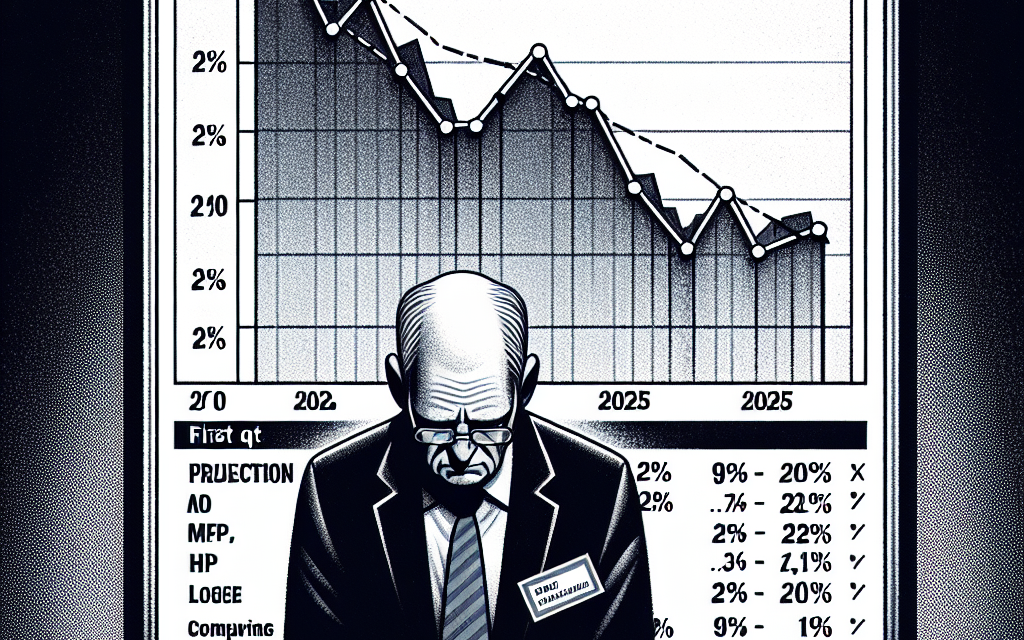UnitedHealth Reports Disappointing Q1 Results and Lowers 2025 Forecast
In the ever-evolving landscape of healthcare, UnitedHealth Group, one of the largest healthcare companies in the United States, has recently made headlines by reporting disappointing first-quarter results for 2023. The company has also lowered its earnings forecast for 2025, raising concerns among investors and analysts alike. This article delves into the implications of these results, the factors contributing to the downturn, and what it means for the future of UnitedHealth and the broader healthcare sector.
1. Overview of UnitedHealth’s Q1 Results
UnitedHealth Group’s Q1 results for 2023 have sparked significant discussion in financial and healthcare circles. The company reported a net income of $5.6 billion, or $5.40 per share, which fell short of analysts’ expectations. This was a stark contrast to the previous year’s performance, where the company had reported a net income of $6.1 billion, or $5.55 per share. The decline in earnings can be attributed to several factors, including rising healthcare costs, increased competition, and regulatory challenges.
Key highlights from the Q1 report include:
- Revenue growth of 12% year-over-year, reaching $80 billion.
- Medical care ratio increased to 83.5%, up from 82.5% in the previous year.
- Enrollment in Medicare Advantage plans grew by 10% compared to Q1 2022.
- Operating income decreased by 5% year-over-year.
The disappointing earnings report has led to a decline in UnitedHealth’s stock price, reflecting investor concerns about the company’s ability to navigate the current healthcare landscape effectively. Analysts have pointed out that while revenue growth is promising, the rising medical care ratio indicates that the company is spending more on healthcare services than it is receiving in premiums, which could pose long-term sustainability issues.
2. Factors Contributing to Disappointing Results
Several factors have contributed to UnitedHealth’s disappointing Q1 results. Understanding these factors is crucial for stakeholders looking to gauge the company’s future performance.
2.1 Rising Healthcare Costs
One of the most significant challenges facing UnitedHealth is the rising cost of healthcare services. The COVID-19 pandemic has exacerbated existing issues, leading to increased demand for medical services and higher prices for treatments. According to a report from the Kaiser Family Foundation, healthcare spending in the U.S. is projected to reach $6 trillion by 2027, driven by factors such as:
- Increased prevalence of chronic diseases.
- Higher prices for prescription drugs.
- Labor shortages in the healthcare sector, leading to increased wages.
These rising costs have directly impacted UnitedHealth’s medical care ratio, which measures the percentage of premiums spent on medical services. A higher ratio indicates that the company is spending more on care than it is collecting in premiums, which can erode profitability.
2.2 Increased Competition
The healthcare market is becoming increasingly competitive, with new entrants and existing players vying for market share. Companies like CVS Health and Anthem have ramped up their efforts in the Medicare Advantage space, which has traditionally been a stronghold for UnitedHealth. This increased competition has led to:
- Price wars, which can drive down premiums.
- Innovative service offerings that attract members away from UnitedHealth.
- Increased marketing expenditures to retain and attract customers.
As competitors continue to innovate and offer attractive plans, UnitedHealth may find it challenging to maintain its market position without significant investment in new services and technologies.
2.3 Regulatory Challenges
The healthcare industry is heavily regulated, and changes in regulations can have a profound impact on companies like UnitedHealth. Recent legislative changes aimed at controlling drug prices and expanding access to healthcare have created uncertainty in the market. For instance, the Inflation Reduction Act includes provisions that allow Medicare to negotiate prices for certain high-cost drugs, which could affect UnitedHealth’s profitability in the long run.
Additionally, regulatory scrutiny over healthcare mergers and acquisitions has increased, making it more challenging for UnitedHealth to pursue growth through acquisitions. This regulatory environment can stifle innovation and limit the company’s ability to adapt to changing market conditions.
3. Implications of Lowered 2025 Forecast
In light of its disappointing Q1 results, UnitedHealth has lowered its earnings forecast for 2025, which has raised alarms among investors and analysts. The company now expects adjusted earnings per share to be in the range of $24 to $25, down from previous estimates of $26 to $27. This revision has several implications for the company and its stakeholders.
3.1 Investor Sentiment
The lowered forecast has led to a decline in investor confidence, as reflected in the stock price drop following the earnings announcement. Investors are concerned about the company’s ability to achieve growth in a challenging environment. A decline in stock price can lead to:
- Increased pressure on management to deliver results.
- Potential changes in leadership if performance does not improve.
- Difficulty in raising capital for future investments.
Investor sentiment is crucial for UnitedHealth, as it relies on market confidence to fund its operations and growth initiatives. A prolonged period of disappointing results could lead to a loss of market share and further declines in stock performance.
3.2 Strategic Reassessment
The lowered forecast may prompt UnitedHealth to reassess its strategic priorities. The company may need to focus on:
- Cost containment measures to improve profitability.
- Investing in technology and innovation to enhance service delivery.
- Exploring partnerships or collaborations to expand its service offerings.
By reassessing its strategy, UnitedHealth can position itself to better navigate the challenges ahead and regain investor confidence. This may involve a shift in focus from aggressive growth to sustainable profitability.
3.3 Impact on Employees and Operations
Lowered earnings forecasts can also have implications for UnitedHealth’s workforce. If the company needs to implement cost-cutting measures, it may lead to:
- Layoffs or hiring freezes.
- Reduced investment in employee training and development.
- Lower morale among employees, impacting productivity.
Maintaining a motivated and skilled workforce is essential for UnitedHealth to deliver quality care and services. Therefore, it is crucial for management to communicate transparently with employees about the company’s direction and any necessary changes.
4. Future Outlook for UnitedHealth
The future outlook for UnitedHealth is uncertain, given the current challenges it faces. However, there are several factors that could influence its trajectory moving forward.
4.1 Emphasis on Technology and Innovation
As the healthcare landscape continues to evolve, technology and innovation will play a critical role in shaping the future of UnitedHealth. The company has already made significant investments in telehealth and digital health solutions, which have gained traction during the pandemic. Moving forward, UnitedHealth may focus on:
- Expanding telehealth services to improve access to care.
- Leveraging data analytics to enhance patient outcomes and reduce costs.
- Investing in artificial intelligence to streamline operations and improve efficiency.
By embracing technology, UnitedHealth can differentiate itself from competitors and improve its service offerings, potentially leading to increased member satisfaction and retention.
4.2 Diversification of Services
To mitigate risks associated with rising healthcare costs and increased competition, UnitedHealth may consider diversifying its service offerings. This could involve:
- Expanding into new markets or geographic regions.
- Developing new insurance products tailored to specific demographics.
- Enhancing partnerships with healthcare providers to offer integrated care solutions.
Diversification can help UnitedHealth reduce its reliance on traditional insurance models and create new revenue streams, ultimately improving its financial stability.
4.3 Focus on Value-Based Care
The shift towards value-based care is gaining momentum in the healthcare industry, and UnitedHealth is well-positioned to capitalize on this trend. By focusing on value-based care models, the company can:
- Align incentives with healthcare providers to improve patient outcomes.
- Reduce unnecessary healthcare spending by emphasizing preventive care.
- Enhance member engagement through personalized care plans.
Value-based care not only improves patient outcomes but can also lead to cost savings for both the company and its members, making it a win-win scenario.
5. Conclusion: Key Takeaways
UnitedHealth’s disappointing Q1 results and lowered 2025 forecast have raised significant concerns among investors and analysts. The company faces several challenges, including rising healthcare costs, increased competition, and regulatory hurdles. However, by focusing on technology, diversifying its services, and embracing value-based care, UnitedHealth can position itself for future success.
Key takeaways from this analysis include:
- The importance of managing rising healthcare costs to maintain profitability.
- The need for strategic reassessment in light of increased competition and regulatory challenges.
- The potential for technology and innovation to drive future growth and improve service delivery.
- The benefits of diversifying services to mitigate risks and create new revenue streams.
- The significance of adopting value-based care models to enhance patient outcomes and reduce costs.
As UnitedHealth navigates these challenges, stakeholders will be closely watching its strategic decisions and operational adjustments. The company’s ability to adapt to the changing healthcare landscape will ultimately determine its long-term success and sustainability.





